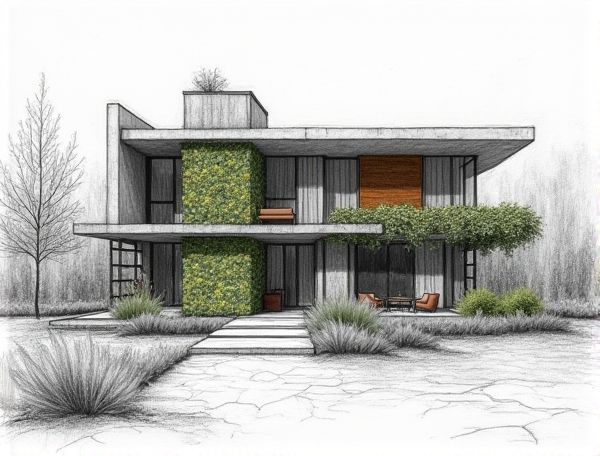
Photo illustration: Biophilic home design with integrated vertical hydroponic walls
Incorporating biophilic design with integrated vertical hydroponic walls transforms your living space into a lush, air-purifying oasis that enhances well-being and promotes sustainable living. Discover practical tips and inspiring ideas to bring nature indoors by reading more in the article.
Introduction to Biophilic Home Design
Biophilic home design integrates natural elements such as plants, natural light, and organic materials to create living spaces that enhance well-being and connect occupants with nature. This design approach improves indoor air quality, reduces stress, and fosters a healthier, more sustainable environment.
The Concept of Vertical Hydroponic Walls
Vertical hydroponic walls maximize space efficiency and promote sustainable urban gardening by allowing plants to grow upward using nutrient-rich water solutions. This innovative system improves air quality and thermal insulation in homes while enabling year-round crop production without soil. Integrating vertical hydroponic walls in home design enhances aesthetic appeal and supports eco-friendly living by conserving water and reducing the need for pesticides.
Benefits of Integrating Nature Indoors
Integrating nature indoors enhances air quality by increasing oxygen levels and reducing pollutants, promoting a healthier living environment. Natural elements such as plants and natural light improve mental well-being, reducing stress and boosting productivity. Incorporating biophilic design also increases property value by creating aesthetically pleasing and energy-efficient spaces.
Space Optimization with Vertical Gardens
Maximize your living area by incorporating vertical gardens, which utilize wall space to create lush, green environments without sacrificing floor area. Vertical gardens improve air quality, enhance aesthetics, and provide natural insulation, making your home both beautiful and energy-efficient.
Essential Plant Choices for Hydroponic Walls
Lush pothos, resilient ferns, and vibrant philodendrons are essential plant choices for hydroponic walls due to their adaptability and air-purifying qualities. These species thrive in nutrient-rich water systems, enhancing indoor aesthetics while promoting healthier living environments.
Improving Air Quality Through Biophilic Design
Incorporating natural elements such as indoor plants, living walls, and water features enhances air quality by increasing oxygen levels and reducing pollutants in your home environment. Utilizing biophilic design principles connects you with nature, promoting healthier indoor air through improved ventilation and natural filtration. Strategic placement of greenery not only purifies the air but also contributes to a calming, toxin-free living space.
Energy Efficiency and Sustainability Features
Incorporating energy-efficient windows, high-performance insulation, and LED lighting significantly reduces energy consumption and lowers utility costs in home design. Utilizing renewable energy sources such as solar panels and geothermal systems supports sustainability by minimizing carbon footprint. Designing with sustainable materials like bamboo flooring and recycled steel enhances durability while promoting environmental responsibility.
Smart Technology Integration in Hydroponic Systems
Smart technology integration in hydroponic systems enhances home gardening by automating nutrient delivery, lighting, and climate control through IoT-enabled sensors and apps. These systems optimize plant growth by precisely monitoring pH, humidity, and nutrient levels in real-time, reducing water usage by up to 90% compared to traditional soil gardening. Home designers incorporate smart hydroponics to create sustainable, space-efficient green environments that promote year-round fresh produce indoors.
Maintenance Tips for Vertical Hydroponic Walls
Regularly inspect your vertical hydroponic wall for clogged drip emitters and nutrient film system channels to ensure optimal water flow and nutrient delivery. You can extend the lifespan of your installation by cleaning filters monthly and monitoring pH and electrical conductivity levels weekly for balanced plant growth.
Inspiring Biophilic Home Design Case Studies
Explore inspiring biophilic home design case studies that seamlessly integrate natural elements like indoor gardens, natural light, and sustainable materials, enhancing both aesthetics and well-being. Your living space can transform into a calming retreat that fosters a deep connection with nature, improving air quality and mental health through thoughtful, nature-driven architecture.
 homedesy.com
homedesy.com